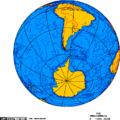- Drake Passage
-
 Drake Passage showing the boundary points A, B, C, D, E and F accorded by the Treaty of Peace and Friendship of 1984 between Chile and Argentina
Drake Passage showing the boundary points A, B, C, D, E and F accorded by the Treaty of Peace and Friendship of 1984 between Chile and Argentina
The Drake Passage or Mar de Hoces—Sea of Hoces—is the body of water between the southern tip of South America at Cape Horn, Chile and the South Shetland Islands of Antarctica. It connects the southwestern part of the Atlantic Ocean (Scotia Sea) with the southeastern part of the Pacific Ocean and extends into the Southern Ocean. The passage receives its English language name from the 16th century English privateer Sir Francis Drake. Drake's only remaining ship, after having passed through the Strait of Magellan, was blown far South in September of 1578. This incident implied an open connection between the Atlantic and Pacific oceans.
Half a century earlier, after a gale had pushed them South from the entrance of the Strait of Magellan, the crew of the Spanish navigator Francisco de Hoces thought they saw a land's end and possibly inferred this passage in 1525.[1] For this reason, some Spanish and Latin American historians and sources call it Mar de Hoces after Francisco de Hoces.
The first recorded voyage through the passage was that of the Eendracht, captained by the Dutch navigator Willem Schouten in 1616, naming Cape Horn in the process.
The 800 kilometres (500 mi) wide passage between Cape Horn and Livingston Island is the shortest crossing from Antarctica to the rest of the world's land. The boundary between the Atlantic and Pacific Oceans is sometimes taken to be a line drawn from Cape Horn to Snow Island 130 kilometres (81 mi) north of mainland Antarctica). Alternatively the meridian that passes through Cape Horn may be taken as the boundary. Both boundaries lie entirely within the Drake Passage.
The other two passages around Cape Horn, Magellan Strait and Beagle Channel, are very narrow, leaving little room for a ship, particularly a sailing ship, to maneuver. They can also become icebound, and sometimes the wind blows so strongly no sailing vessel can make headway against it. Hence most sailing ships preferred the Drake Passage, which is open water for hundreds of miles, despite very rough conditions. The very small Diego Ramírez Islands lie about 50 kilometres (31 mi) south of Cape Horn.
There is no significant land anywhere around the world at the latitudes of the Drake Passage, which is important to the unimpeded flow of the Antarctic Circumpolar Current which carries a huge volume of water (about 600 times the flow of the Amazon River) through the Passage and around Antarctica.
Ships in the passage are often good platforms for the sighting of whales, dolphins and plentiful seabirds including giant petrels, other petrels, albatrosses and penguins.
The passage is known to have been closed until around 41 million years ago[2] according to a chemical study of fish teeth found in oceanic sedimentary rock. Before the passage opened, the Atlantic and Pacific Oceans were separated entirely with Antarctica being much warmer and having no ice cap. The joining of the two great oceans started the Antarctic Circumpolar Current and cooled the continent significantly.
-
Drake Passage or Mar de Hoces between South America and Antarctica
See also
- Sir Francis Drake
- García de Nodal
- Straits of Magellan
- Beagle Channel
References
- ^ Oyarzun, Javier, Expediciones españolas al Estrecho de Magallanes y Tierra de Fuego, 1976, Madrid: Ediciones Cultura Hispánica ISBN 84-7232-130-4
- ^ Helen Briggs (21 April 2006). "Fossil gives clue to big chill". BBC News. http://news.bbc.co.uk/1/hi/sci/tech/4928010.stm. Retrieved 2007-11-01.
External links
- National Oceanography Centre, Southampton page of the important and complex bathymetry of the Passage
- A personal story describing crossing the Passage
- A NASA image of an eddy in the Passage
- Larger-scale images of the passage from the US Navy (Rain, ice edge and wind images)
Coordinates: 58°34′49″S 62°54′34″W / 58.58028°S 62.90944°W
Categories:- Straits of Chile
- Straits of Antarctica
- Geography of Magellan and Chilean Antarctica Region
- Borders of Chile
- Antarctic region
-
Wikimedia Foundation. 2010.



